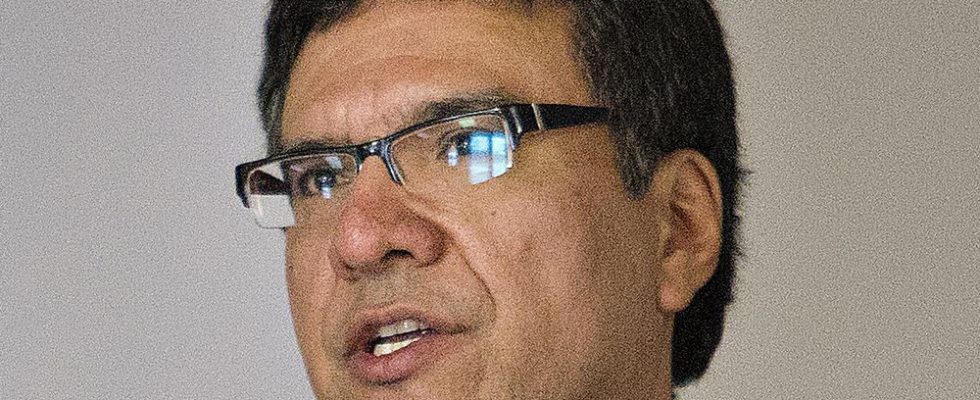
A Haudenosaunee delegation is in Geneva, Switzerland, to unveil a photo exhibit highlighting a century-long struggle to advance Indigenous rights at the United Nations.
The group of about 30 people is headed by Steve Jacobs, the deskaheh, or chief, of the Cayuga Bear Clan, and includes supporters of the Haudenosaunee Chiefs Confederacy Council from Six Nations, upstate New York, and Akwesasne and Kahnawake in Quebec.
It was a past Cayuga Deskaheh, Levi General, who went to the League of Nations in Geneva in 1923 to protest the subjugation of Indigenous peoples by the Canadian government.
Ottawa had stationed the Royal Canadian Mounted Police on Six Nations territory and was putting pressure on band members “to abolish the Confederacy traditional system of governance in favor of the elected council,” said Rick Monture, a Haudenosaunee scholar from Six Nations who teaches Indigenous studies at McMaster University.
“The Confederacy was getting pretty upset about this, so Deskaheh went to England to try and get the attention of the British Crown,” Monture said.
“That failed, so he went to the League of Nations.”
Deskaheh, as Levi General was known internationally, was not granted an audience at the forerunner of the United Nations “because we weren’t a recognized nation,” Monture said.
But the people of Geneva became fascinated by their Indigenous guest, with the mayor inviting Deskaheh to make his speech directly to residents.
“He was kind of a media and cult celebrity in the city,” Monture said.
Over the next 18 months, Deskaheh gave public lectures throughout Switzerland, telling his European hosts about the Two Row Wampum (an agreement between the Haudenosaunee and Dutch settlers “to never interfere in one another’s government, laws and ways”), the theft of Indigenous lands along the Grand River by colonial authorities, and how Britain turned its back on a treaty partner by allowing Ottawa, through the Indian Act, to usher in what Deskaheh called “the complete destruction of our government and the obliteration of the Iroquois race that would soon follow.”
Back home, Ottawa’s campaign to clamp down on Six Nations’ traditional leadership culminated in the forcible removal of the Confederacy in 1924. Fearing arrest, Deskaheh went to a Haudenosaunee community in New York state, where he died of pneumonia in 1925.
Today, Deskaheh is considered the first Indigenous person to bring global attention to the loss of land and sovereignty at the hands of European colonial powers. His efforts, Monture said, “gave rise” to the push for Indigenous rights that led to the United Nations Declaration on the Rights of Indigenous Peoples (UNDRIP) in 2007.
One hundred years after Deskaheh landed in Geneva, the city is commemorating his visit.
An eastern white pine was planted in February as a “tree of peace” symbolizing the enduring relationship between Genevans and the Haudenosaunee, while the city’s museum of ethnography returned two sacred objects to the Haudenosaunee.
An outdoor exhibit called “Deskaheh in Geneva 1923-2023: Defending Haudenosaunee Sovereignty” will be formally unveiled on the banks of Lake Geneva on July 18, with a public ceremony and procession that will include the Haudenosaunee delegation and Indigenous visitors from around the world who are in Geneva for a UN conference on Indigenous rights.
Mount sourced photographs and contributed text for the exhibit panels, which will be on display until Aug. 16. Among the images is a Hamilton Spectator photograph showing a rally in support of 1492 Land Back Lane, an ongoing Indigenous land defense effort on disputed territory in Caledonia.
That image was chosen to illustrate how the Haudenosaunee remain “at the forefront of this international struggle” for Indigenous sovereignty and land rights, just as they were 100 years ago, Monture said.
“The exhibit is to demonstrate that Indigenous people have challenged colonialism and put up resistance against overwhelming odds for at least a century,” he said.
JP Antonacci is a Local Journalism Initiative Reporter based at the Hamilton Spectator. The initiative is funded by the Government of Canada.

Comments
Postmedia is committed to maintaining a lively but civil forum for discussion and encourages all readers to share their views on our articles. Comments may take up to an hour for moderation before appearing on the site. We ask you to keep your comments relevant and respectful. We have enabled email notifications—you will now receive an email if you receive a reply to your comment, there is an update to a comment thread you follow or if a user you follow comments. Visit our Community Guidelines for more information and details on how to adjust your email settings.
Join the Conversation